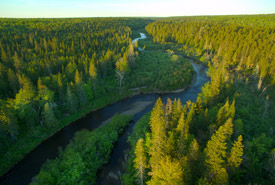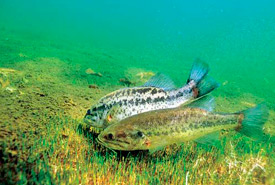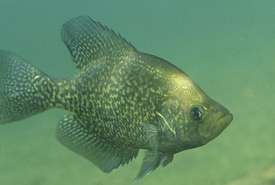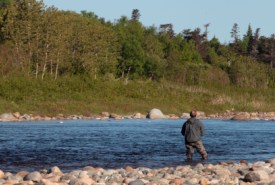Something’s Fishy: On the down low

Aerial view of Foxner Nature Reserve, NB (Photo by Mike Dembeck)
Many freshwater fish are extremely susceptible to changes in the waters they live in. Pollution and sediments can all impact the health of lakes, rivers and streams. But did you know that temperature can impact the amount of oxygen in the water?
Fish breathe through their gills, which function by passing water through them and absorbing the oxygen in the water. When water temperature increases, oxygen levels decrease. This means less oxygen in the water, making it harder for some fish to breathe.

Largemouth bass spawning (Photo by Mississippi Sportsman)
While some fish need colder waters, such as many trout species, there are freshwater species, like largemouth bass, catfish and crappies, that tolerate and even thrive in warmer water. These species are able to withstand lower oxygen levels in the water. But if oxygen levels get too low, even the most warm water tolerant fish cannot survive.
Oxygen in the water can fluctuate based on a number of factors, including the amount of groundwater inputs, sediment runoff, pollution, water flow and vegetation. For example, a stream that flows through a forest will remain cool because of shading.
How you can help keep fish happy
In order to keep freshwater ecosystems healthy for fish, we need to ensure that we understand the types of freshwater ecosystems that need to be monitored and protected.

Black crappie (Photo by Eric Engbretson, USFWS)
Take the Freshwater Conservation Blueprint. This project is created and led by conservation staff from the Nature Conservancy of Canada’s (NCC’s) Atlantic Region. Under this project, all the rivers and streams in New Brunswick, Nova Scotia, PEI and eastern Quebec have been classified and assessed (along with those that feed into New Brunswick and Quebec from northern U.S.).

Crabbes River Nature Reserve, NL (Photo by Mike Dembeck)
“This project was designed to assist municipal, provincial and natural resource planners, watershed organizations and other conservation groups in making decisions that will help protect aquatic and riparian area species and habitats,” says Pat Nussey, conservation science and planning lead for NCC’s Atlantic Region. “Our hope is that the information provided here will be incorporated into conservation and land-use planning as decision-makers consider how climate change and other threats could impact streams and rivers over time.”
This suite of five tools were developed to help assess the health of aquatic and riparian ecosystems for New Brunswick, Nova Scotia, PEI and southern Quebec:
- The Active River Area
- Aquatic Connectivity Tool
- Freshwater Resilience to Climate Change
- Stream Classification (v2.0)
- Watershed Health Assessment
The goal is to use this information to improve conservation throughout the region and across borders to enable better planning and conservation across watersheds, provinces and even between Canada and the U.S. By increasing what we know about these rivers and streams, NCC, other conservation organizations and governments can use this information to manage and improve habitat for the species that live there.


